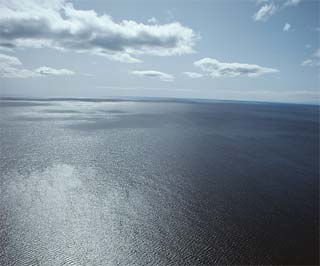Marine - Offshore Waters
 Offshore waters extend from about ten miles beyond the coast to the edge of the continental shelf making this area the state’s largest aquatic habitat. Depths vary from 50 feet to well over 600 feet, providing habitat for free-swimming and well as bottom- dwelling organisms.
Offshore waters extend from about ten miles beyond the coast to the edge of the continental shelf making this area the state’s largest aquatic habitat. Depths vary from 50 feet to well over 600 feet, providing habitat for free-swimming and well as bottom- dwelling organisms.
About 75 miles offshore, the warm Gulf Stream flows north out of the Florida Straits. This ocean current averages 62 miles in width with a speed of about five knots. Water temperature in the Gulf Stream averages 68 degrees, but exceeds 80 degrees for much of the year.
The irregular ocean floor, especially a raised area known as the Charleston Bump, breaks off portions of the Gulf Stream into giant eddies, spinning warm water and the organisms associated with it inshore from the main current.
Offshore waters maintain a fairly constant temperature and salinity with little turbidity. The warm surface water and abundant sunlight allow production of algae and other phytoplankton.
Other surface dwelling organisms include jellyfish, squid, and many small species of fish such as anchovies, flying fish and ballyhoo. Larger predatory animals, including dolphins and whales as well as many fishes feed on these smaller organisms.
Important fish species in offshore surface waters include king and Spanish mackerel, wahoo, several species of tuna, dolphin (mahi-mahi), sailfish, marlin and swordfish. Some of these fishes occur singularly, others in large schools.
Offshore deep waters are home to a variety of species, including many schooling fish like crevalle jack and Atlantic spadefish.
Species that spend much of the spring and summer in inshore waters as well as juveniles that have matured in estuaries move to deeper, and often warmer, more stable offshore waters during the late fall and winter, making this habitat vital to many organisms. Species that may make this movement include black drum, red drum, flounder, cobia and southern kingfish.
